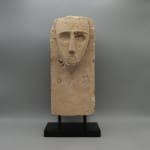Sabean Stone Plaque, 400 BCE - 200 BCE
Limestone
height 29.5 cm
height 11 5/8 in
height 11 5/8 in
AM.0142
Further images
The ancient kingdom of Saba ruled over the lands of southern Arabia, centered in modern day Yemen. Saba is perhaps better known as Sheba, the Hebrew word for the kingdom,...
The ancient kingdom of Saba ruled over the lands of southern Arabia, centered in modern day Yemen. Saba is perhaps better known as Sheba, the Hebrew word for the kingdom, whose famous Queen was recounted as having visited Solomon in the pages of the Old Testament. Biblical accounts speak of the wealth of this ancient civilization of traders and merchants, and modern archaeological excavations confirm these reports. Ruins of fortresses and walled towns are evident and remnants of their extensive irrigation system that turned the desert into a paradise still cover the land. Although gold and silver deposits were present, the chief source of their vast wealth was derived from their veritable monopoly of two of the most coveted materials in ancient times: frankincense and myrrh, resinous gums obtained from certain trees that only grow in Southern Arabia and were literally worth their weight in gold. There was not a temple or wealthy house in the ancient world, from Babylon to Rome, where one would not smell the fragrant scents of these incenses. In addition, a trade route that connected India to Egypt that passed through their capital of Marib was another major source of wealth. In the 1st Century A.D., the Ptolemaic Greeks discovered a sea route from India directly to the port of Alexandria, eliminating Saba from her lucrative trade and ushering in the decline of Sabean prosperity.
This magnificent stone funerary plaque is a stunning example of the sophistication of Sabean art. The following is a transcription of the analysis kindly provided by Professor Kitchen (University of Liverpool).
‘This ‘headpiece’ was originally inserted into a matching rectangular recess, cut into a tall stela (like a narrow quadrangular pillar), to form a tombstone plus ‘formal’ portrait. For intact examples, cf. St. John Simpson (ed.), ‘Queen of Sheba, Treasures from Ancient Yemen,’ (London, British Museum, 2002), p. 198, nos. 277-278.
Facial tombstone in moderately high relief, with semi-circular ears, a thin fringe of hair across the top, level eyebrows, beard and slit mouth (no lips). The text is a three-letter name, m tc- - Matic. This name is known best in the north (cf. R. L. Cleveland, ‘An Ancient South-Arabian Necropolis…Timna Cemetary,’ (Baltimore, 1965), p. 526), and there are also a few examples in the southern kingdoms (cf. S.F. Al-Said, ‘Die Personennamen in den Minäischen Inschriften,’ (Wiesbaden, 1995), p. 158 for related names in Sabean, Qatabanian and Hadramautic). The script is barely dateable; on general considerations, the 4th/3rd centuries BC may suit.’
This magnificent stone funerary plaque is a stunning example of the sophistication of Sabean art. The following is a transcription of the analysis kindly provided by Professor Kitchen (University of Liverpool).
‘This ‘headpiece’ was originally inserted into a matching rectangular recess, cut into a tall stela (like a narrow quadrangular pillar), to form a tombstone plus ‘formal’ portrait. For intact examples, cf. St. John Simpson (ed.), ‘Queen of Sheba, Treasures from Ancient Yemen,’ (London, British Museum, 2002), p. 198, nos. 277-278.
Facial tombstone in moderately high relief, with semi-circular ears, a thin fringe of hair across the top, level eyebrows, beard and slit mouth (no lips). The text is a three-letter name, m tc- - Matic. This name is known best in the north (cf. R. L. Cleveland, ‘An Ancient South-Arabian Necropolis…Timna Cemetary,’ (Baltimore, 1965), p. 526), and there are also a few examples in the southern kingdoms (cf. S.F. Al-Said, ‘Die Personennamen in den Minäischen Inschriften,’ (Wiesbaden, 1995), p. 158 for related names in Sabean, Qatabanian and Hadramautic). The script is barely dateable; on general considerations, the 4th/3rd centuries BC may suit.’









